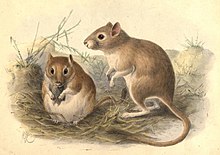Midday jird
| Midday jird | |
|---|---|

| |
| Scientific classification | |
| Kingdom: | |
| Phylum: | |
| Class: | |
| Order: | |
| Family: | |
| Genus: | |
| Subgenus: | |
| Species: | M. meridianus
|
| Binomial name | |
| Meriones meridianus (Pallas, 1773)
| |
The midday jird, or midday gerbil (Meriones meridianus), is a species of rodent in the family Muridae and native to sandy deserts in Afghanistan, China, Iran, Azerbaijan, Kazakhstan, Kyrgyzstan, Mongolia, Russia, Tajikistan, Turkmenistan, and Uzbekistan. How this rodent received its common name is unclear as it is mainly nocturnal.[2]
Description
The midday jird is a medium-sized species with a head-and-body length of 95 to 134 mm (3.7 to 5.3 in), a tail of a similar length, and a weight of 30 to 60 g (1.1 to 2.1 oz). The upper parts are pale yellowish-grey, drab or darker brown, the hairs having blackish bases. The underparts are white with a light brown strip across the chest. The tail is brown or ochre above and slightly paler below. The claws are white, and the soles of the hind feet are densely hairy so that no bare skin is visible.[2]
Distribution and habitat
The midday jird is found in much of central and eastern Asia. Its range extends from the Caspian sea through Kazakhstan and southern Russia to northern China and southern Mongolia. Its southern limit is northeastern Iran and northern Afghanistan. An isolated population reported to be present in Armenia and eastern Turkey probably referred to Dahl's jird (Meriones dahli).[3] Its typical habitat is sandy deserts, alluvial plains and especially arid sandy areas in hilly deserts with a scattering of scrub.[1]
Ecology
The midday jird lives in large colonies with complex social structures. The entrance to the burrow is usually at the base of a plant and the tunnels may extend for up to 4 m (13 ft) horizontally and half of this vertically, being deeper in winter. This jird is mainly nocturnal, but may emerge in daylight in autumn and winter. The diet is mainly seeds and fruits, but insects and some green vegetation are also eaten. Small amounts of food are stored in the burrow. Breeding takes place mainly in the spring and autumn with litters averaging about six young.[1][2]
The sandy floor of Aralkum, the man-made desert that has been formed as a result of the shrinkage of the Aral Sea,[4] has been colonised by the midday jird, which is the commonest rodent present; other small rodents include the northern three-toed jerboa, the Libyan jird and, in places, the great gerbil.[5] These animals are about four times more abundant on the dried-up seabed than in the surrounding area, and the plentiful supply of food they provide has attracted carnivores including the red fox, the corsac fox, the steppe polecat, the marbled polecat and the Turkestan wildcat.[5]
Status
The midday jird is a common species in suitable habitat across its wide range. It is capable of large population swings depending on the harshness of the winter weather and the availability of food. No special threats have been identified, and the International Union for Conservation of Nature has assessed its conservation status as "least concern".[1]
References
- ^ a b c d Template:IUCN
- ^ a b c Smith, Andrew T.; Xie, Yan; Hoffmann, Robert S.; Lunde, Darrin; MacKinnon, John; Wilson, Don E.; Wozencraft, W. Chris (2010). A Guide to the Mammals of China. Princeton University Press. p. 250. ISBN 1-4008-3411-2.
- ^ Wilson, Don E.; Reeder, DeeAnn M. (2005). Mammal Species of the World: A Taxonomic and Geographic Reference. JHU Press. p. 1237. ISBN 978-0-8018-8221-0.
- ^ Morais, Caitlin Dempsey (28 May 2014). "Aralkum Desert: The World's Newest Desert". Geo Lounge. Retrieved 23 December 2015.
- ^ a b Breckle, Siegmar-W.; Wucherer, Walter; Dimeyeva, Liliya A.; Ogar, Nathalia P. (2011). Aralkum, a Man-Made Desert: The Desiccated Floor of the Aral Sea (Central Asia). Springer Science & Business Media. p. 240. ISBN 978-3-642-21117-1.

